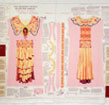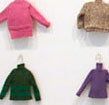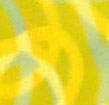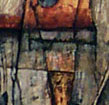
Exhibitions: Current | Upcoming | Past
Exhibitions: Past
On 40 at 40
A National Juried Exhibition
Juror: Judith Tannenbaum & Richard Brown Baker
Works by Catherine Carter, Jeff Carpenter, Keith Borges, Dave Brown, Brandon Sanderson, Kathleen Petry, Rupert Nesbitt, Anni Abbi, B. Lynch, Lori Brown, and Sherrill Hunnibell
January 26 – February 23, 2006




Bristol Community College's Grimshaw-Gudewicz Art Gallery offers another 40th Anniversary celebratory event with On 40 At 40, a National Juried Exhibition. Artists from across the country were invited to submit works that in some way are relevant to the number 40. Works could incorporate elements regarding time, milestones, passages, attainment, change, or evolution.
What is in a number? The American Heritage Dictionary of the English Language defines a number as one of a series of symbols of unique meaning in a fixed order that can be derived by counting. The online publication Wikepedia provides several descriptions for the number 40. For example, 40 is the natural number following 39 and preceding 41. In English, forty is the only number whose constituent letters appear in alphabetical order. It is also one of several numbers that is associated with symbolic meaning.
The number 40 has had particular significance throughout various cultures and was important to the peoples of ancient Babylonia, Egypt, and Mexico. It is also relevant to Judaism, Christianity, and the Islam faith. It has been suggested that the number's significance is simply quantitative: there are 40 days of Lent, or that the number symbolizes a period of trial and privation. But for many ancient peoples, the number probably symbolized a length or period of time of almost unimaginable duration – that just beyond a lifetime. A period of rain lasting 40 days, or a punishment of 40 lashes represented a span of as much as could be imagined or comprehended. Perhaps in the way we measure the span of 100 years as lying just beyond that of a life lived, ancient peoples looked at this number in a similar way.
Although for most cultures, life-expectancy has risen sharply in the last century, most of us still measure 40 years as an important achievement. And though it is a significant length of time, a threshold for each of us, a turning point perhaps, we are eager to explore the territory ahead.
Eleven artists are represented in this exhibition, and, through their work, each offer distinctive insights about the number. From Catherine Carter's pathways of life, Jeff Carpenter's layers of an onion, Keith Borges' metaphor of the open box, Dave Bown's birthday wishes, Kathleen Petry's memory sweaters, Brandon Sanderson's mechanical evolution, Rupert Nesbitt's reference to electrical current and energy, Anni Abbi's 1940s dress pattern, B. Lynch's reworking of ancient myths, Lori Brown's markers of time, to Sherrill Hunnibell's layered and excavated collage, their works encompass the broadest range of opportunity to contemplate the definition of 40.
Kathleen Hancock
Director
The Artists
Catherine Carter
The lines in these paintings symbolize the pathways of life.
Some lines surge forward, as when we set forth in a new direction with certainty and determination. Some lines spin in seeming confusion, like the unexpected twists and turns we encounter along the way. Some lines drop, like the doubts and failures that plunge us into despair. Some are tense knots, like the problems we struggle against, and some flow, like those harmonious times when everything somehow falls into place.
Always, there is change, the "healing of all wounds" that takes place as time relentlessly flows along.
Ultimately, the lines go off the edges of the canvas and seem to continue their journey beyond our view, in much the same way that our lives go on after our apparent physical death in ways that we cannot currently see or even fathom.
Jeff Carpenter
If you think of a fond memory of a wonderful day, it's rarely just one snapshot; it is many images - the full panorama, the light in her eyes, the wind in the leaves - all layered one on top of each other. To summon them is like peeling through the layers of an onion. The real pleasure in conjuring up the memory is not so much in any one picture as it is in moving through the layers. My work is concerned with that effect, to combine images in a way that evokes the subconscious process. Sometimes it's a simple combination of images, side-by-side, or sometimes it's a superimposition of images such as double-exposure or pentimento – the faint traces of a map or poetry ghosting through the image. Sometimes it's multiple images in sequence, such as the lenticular prints. In each case it sets the mind to switching from one image to the next, back and forth, a mental flickering that is slightly beyond our control that makes us the projector in an abstract movie.
Keith Borges
This work utilizes the idea of individual identity in relation to the image of an open box. Identity is exemplified in the forms by each box being the same concept from the commencement to the end of production while the matter of size, weight, surface texture, color and placement are continually changing.Dave Brown
Re: Color
Projects realized after 6 February 2005, could feature a color palette based on the Phi Color Theorem; which is based on the Fibonacci Progression of Numbers.
Re: Code
One of the Cipher Vidi says: happy 40 anniversary.
Re: Modifying Inexpensive Common Commodoties
International icons of lifestyles that transcend social rank. The work is a documentation of the contemporary American consumer and an attempt to liberate hyper-consumerism and a throwaway culture.
Brandon Sanderson
I am fascinated by the symbiosis of man and machine in the contemporary world. We not only use machines as tools to better our existence (or worsen that of our adversaries) – they have gradually become a part of us – we have evolved into mechanically-assisted beings. My interests in this theme are personal, having various 'mechanical' parts myself (such as pins in a knee and a reconstructed inner ear). I find the android and the automaton to be an appropriate symbol of our capacity for alienation and devastation – but also of man's ability to change himself through constant education.
My recent images directly and indirectly reference a science fiction atmosphere similar to that of 50s and 60s B movies but with contemporary fantasy elements. Invasions, apocalypses, revelations, and raptures are environmental characteristics of my work and serve to set the stage (and comment upon) the relationships between an image's central characters.
Having a strong background in computer programming, I am attracted to the emerging range of interfaces between man and machine, both abstract and physical. However, it is not the glorification of the mechanical, nor the use of it, that intrigues me. Rather, I intend to investigate the ramifications of it on the human psyche – to examine how it improves quality of life while propagating a sense of isolation and disconnection. Within my process I hope to not only depict my interest in this paradox, but also to consider the way we see ourselves in the world, and how we interface with it.
Kathleen Petry
In my work I explore the dynamics that exist between the processes of sculpture and printmaking and the rhythms and contrasts between materials and textures. I have been investigating medieval art and culture, especially systems of remembrance, and many of my works are a response to the interrelationships among myth, journey, metaphor, music, object, and memory.
I have explored in many other works Greek and European myths concerning Arachne, weaving, and various stories concerning the origins of the world. I am attracted to such mythic themes – their endurance and broad appeal across language and culture.
This work was made during the years before and after I turned forty. I asked a number of friends and acquaintances to donate a pair of socks – each pair was then cut and re-sewn into a miniature sweater.
Rupert Nesbitt
This image is from a series focusing on believable yet entirely imaginary spaces created using digital 3D software. In this example, electricity and data are used as an analogy for the more esoteric concepts of energy and experience. Those elements are a continuum, and the meter functions as an observer noting an arbitrary point within the flow.
Anni Abbi
Forty, as in the 40s, was, purportedly, when the Hardly Hard Business Dress: the dress to get hired in and the dress to get fired for (pattern) was created – to give credence to feminine inclinations by imploring business to implement tenderness, leniency, mercy, and conciliation. The Hardly Hard gives women the unique opportunity to redress themselves and the business work ethic by softening the hard construct of American business, whose worst fear is "going soft."B. Lynch
The stories of Western Civilization continue to live and be reinvigorated through the centuries. They have embedded themselves cunningly into our unanalyzed selves. I seek to re-examine them critically, to see their essential truths in the light of our own particular predicaments.
Venus, the goddess of love and beauty, obsesses over her looks. The traditional voyeurism of naked Venus paintings is emphasized by the keyhole viewpoint.
Fortuna, goddess of fortune and Roman emperors, carelessly bounces the world as her plaything. Her consort is a snake, which she, conversely to Eve, feeds an apple.
Lori Brown
I am both an architect and an artist. I started using collage in graduate school for architecture as a tool to explore three-dimensional space using various purchased and found paper inherently connected to the sight of exploration. Moving beyond the purely architectural, the collections of paper and various things from my daily life have become a marker of time and events. Working in series, the pieces catalog days, months, sometimes years.
Sherrill Hunnibell
Collage has always been a strong factor in my work. Quite simply, I like the physical process and appreciate the intuitive discoveries that layering encourages. It's a bit like reverse archeology – with surfaces being repeatedly layered and excavated – resulting in a unique documentation of transition in time, space, and circumstance.

